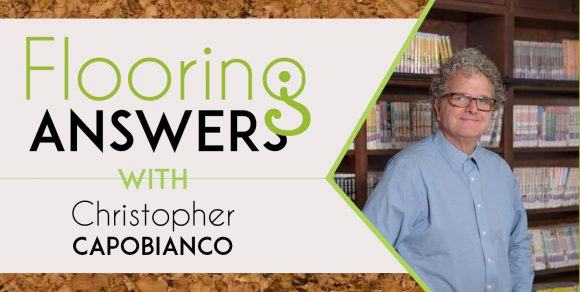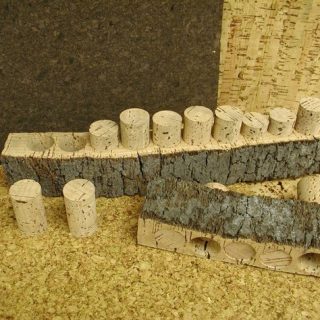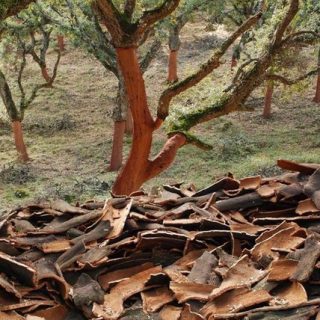Flooring Answers: Cork 101

Check Out the Video Version of Cork 101
Although arguably the most sustainable of all building materials with a long history and a great story, Cork is often misunderstood, so fall for cork with this short introduction on how to specify, install and maintain it.
 The bark of the cork oak tree can be stripped off without damaging the tree and re-grows in about 9 years. We all know cork wine bottle stoppers, which began commercial production in the mid 1700s and are still the #1 use for cork. Going back thousands of years, Cork’s uses were many; from floats for fishing nets, to shoes, to corks for sealing Amphora found in ancient pyramids.
The bark of the cork oak tree can be stripped off without damaging the tree and re-grows in about 9 years. We all know cork wine bottle stoppers, which began commercial production in the mid 1700s and are still the #1 use for cork. Going back thousands of years, Cork’s uses were many; from floats for fishing nets, to shoes, to corks for sealing Amphora found in ancient pyramids.

I really got to know cork when I helped launch 2 cork brands in the U.S. in 2001 and 2007. I’ve seen a fair number of cork floors, done seminars and presentations about cork, written articles and technical manuals about it and curated the creation of the ASTM Cork standard. I visited cork forests and factories to see this“rapidly renewable” material go from trees to wine bottle corks, and then saw the waste turned into beautiful floor coverings. Cork has become my favorite flooring material and my passion for cork lead a friend to give me the nick name “Cork Dork of New York” several years ago, which led me to create my Facebook page where anyone can learn more about cork and see the material from start to finish.
Traditional Cork Tile
Traditional cork tile that is glued to floors or walls has been around over 100 years, and more recently, engineered “floating” cork planks have become popular for their easy installation that uses the same methods as wood or laminate floating floors. For today, we will fall for cork tile.
Cork tile has a lot in common with wood, but it’s cellular structure makes it more comfortable underfoot and provides insulation for sound and heat. Cork is classified as resilient flooring as per ASTM F3008, Standard Specification for Cork Floor Tile, the industry standard. Like any ASTM standard, physical properties and performance are specified and also the two product classes; homogeneous and heterogeneous. Class I Homogeneous shall be of uniform structure and composition throughout*…and Class II Heterogeneous… comprises a veneer layer of cork and ….the pattern of this tile need not extend throughout the entire thickness of the tile.*” This is an important point, especially when floors are being specified for commercial use.
Homogeneous Cork
Homogeneous cork can be sanded and refinished, so it’s used a lot in high traffic. Heterogeneous cork cannot be sanded, so it may not be recommended for heavy traffic, or may need protective coats of finish.
So, ASTM F3008 will certainly help in deciding what kind of cork tile to specify, but what else should be included in the specification?
Cork Specifications
First, to fall for cork, site conditions and material acclimation are critical. The cork tile and the space must be at “in use” temperature and humidity for at least three days before installation and the substrate must be dry, flat and smooth. Test and prepare concrete substrates as per ASTM F710, Standard Practice for Preparing Concrete Flooring to Receive Resilient Flooring.
Second, adhesive selection is essential to successful cork installation. Talking to the experienced cork installers in Europe and here in the United States made me a believer in the decades old method using a water-based contact adhesive that is applied to the back of the tile and to the substrate. The tile is set in place and a rubber mallet is used to make “contact,” so there is an instant bond. Many of the cork tile failures I have seen were caused when someone decided to use a trowel applied adhesive instead of the contact method. Fall for cork by not making that same mistake!
Third, maintenance. Most cork tile is pre-finished with polyurethane and it’s common to add another coat or two for extra protection. From that point, maintain like a wood floor; sweep regularly and damp mop. Wet mopping is not a good idea. Make sure furniture has proper glides, use walk-off mats to keep dirt off the floor and window coverings to minimize fading in bright sunlight.
Cork Success Stories
When installed correctly, cork floor can last years and years. Take a look at a couple of our success stories.
As far back as the 1920s, millions of square feet of cork flooring were installed in North America, but cork use fell off as other synthetic materials grew in popularity. For the past 20 years or so, cork has reemerged. Last year when we were all on lockdown, I presented several webinars about cork and would be glad to do them again if it would help my readers “dig in” to the subject. Interested? Email me at christopher@spartansurfaces.com
I’ll also be presenting one of my cork seminars in person to the International Certified Flooring Installers Association (CFI) at their annual convention on August 18, 2022.
LEARN MORE: International Certified Flooring Installers Association (CFI) Annual Convention
Explore all our Flooring Answer Articles
Explore all our Flooring Answer Videos
ABOUT CHRISTOPHER
Christopher Capobianco covers the NY Metro and Connecticut area for Spartan. He’s a fourth-generation floor coverer whose family has been in the business since the 1930s. For 36 of the last 43 years, he’s had roles in retail, distributor, and manufacturer sales. The other seven years were spent in floor covering training and technical support. He also has been a part time columnist for various flooring magazines since 1988 and is a long-time member of the ASTM Committee on resilient flooring. You can reach him here.

